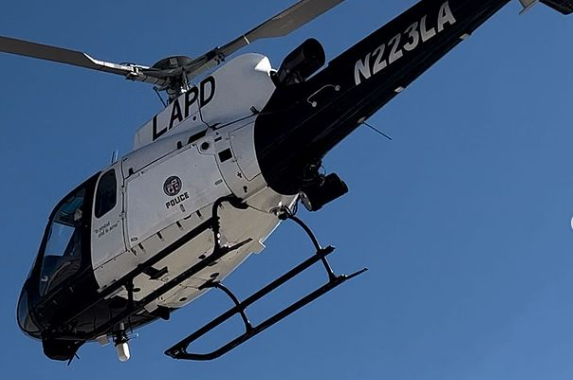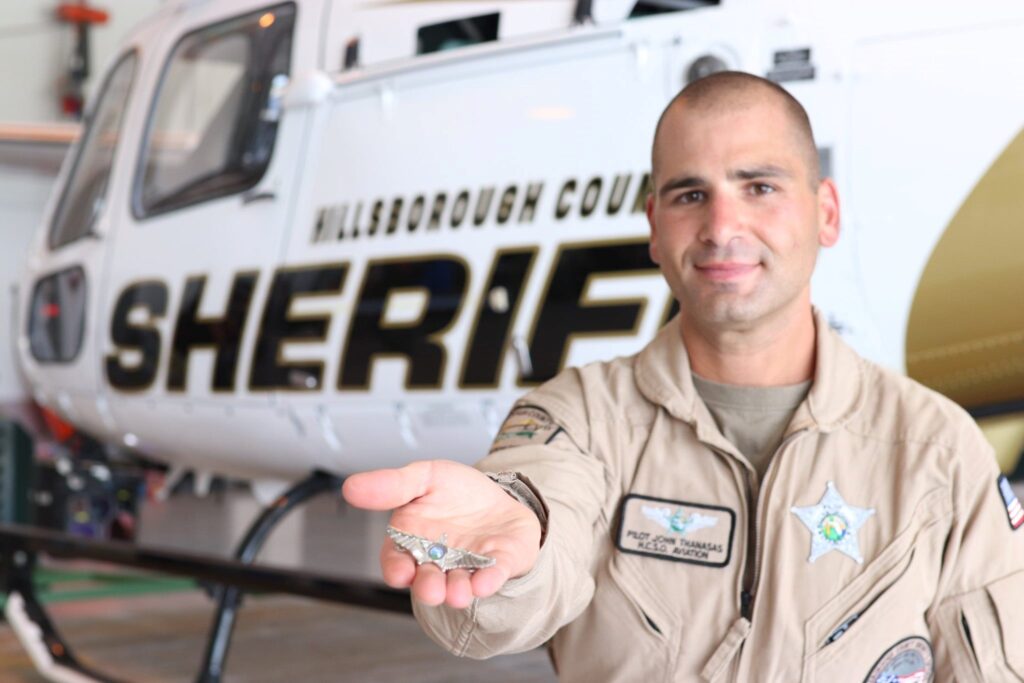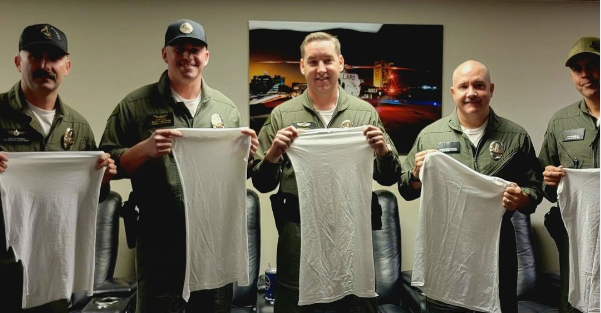
There are several ways for law enforcement officers to catch bad actors. But when they are on the run, in motor vehicles, recklessly coursing through streets and parking lots, it is optimal for the police agency’s Aviation Unit cops to hover overhead and maintain a birds-eye view, calling out plays like a sideline head coach.
The aerial view of pilots operating a police chopper helps keep ground units in cruisers apprised with detailed descriptions and locations to successfully nab nefarious individuals, mindfully eliminating the humongous risks associated with car pursuits and the potential destruction of life, limb, and property.
My county sheriff’s office relies heavily on its Aviation Unit deputies to enable safer police operations by working together with other deputies in varying modes of travel —patrol cars, police motorcycles, and marine units— all connected by police radio.
Let’s take a look at some examples…after which we have some aviator lore, compliments of the Los Angeles Police Department Aviation Unit, having to do with “shirt tails” making for quite a high tale.
First up is probably one of the most common instances nowadays: A motorcyclist evading a police cruiser during a traffic-stop situation.
Most law enforcement agencies have pursuit policies in place to guide patrol officers in making decisions on whether to chase or not. Given inherent dangers for all parties involved in a police pursuit, especially innocent and unsuspecting citizens either in cars or as pedestrians, cops chasing bad actors exercise all precautionary measures. If one is available, a police agency helicopter is vital to safely navigate a chase from an aerial advantage, providing crucial details to street-level officers.
Motorcycles are notoriously faster than cars; I think we can all agree on that. That is why a police chopper already in flight mode can swiftly get to a general area, locate a motorcyclist who fled, and “stay with them” as police cruisers monitor radio transmissions from police pilots overhead, directing/redirecting resources as needed.
In Marion County a few days ago, sheriff’s office helicopter pilots directed a safe operation leading to apprehension by calling out the location and direction of travel, along with other pertinent details, to ground units.
As the male operator and female passenger dumped the motorcycle behind a shopping center and began to run away on foot, street cops were waiting and took both subjects into custody.
According to Marion County Sheriff’s Office (MCSO) reports, “Corporal Richard Demarco attempted a traffic stop on a motorcycle for running a Stop sign.” Wanna guess what happened next?
The 52-year-old motorcycle driver, subsequently identified as Niel Elder, “refused to stop and began to flee at a high rate of speed with a passenger on his motorcycle. Due to the reckless nature of Elder’s driving, Corporal Demarco canceled the pursuit out of a concern for the safety of Elder’s passenger.” That talks to the issue of pursuit policies we mentioned above.
In such a case, patrol officers/deputies broadcast the “last known direction of travel” and reiterate descriptions and chargeable offense(s). With that in mind…
“Deputy Brittany Fisher later located Elder driving on Southeast Maricamp Road, near the Silver Springs Shores [Sheriff’s] District Office. She attempted to conduct a second traffic stop, but Elder fled from her and drove through multiple red lights. The Marion County Sheriff’s Office (MCSO) Aviation Unit arrived in the area and located Elder using the camera capabilities of AIR-1. AIR-1 maintained visual contact with Elder and provided updates about his location to the deputies below.”
The camera capabilities referred to here are what is seen in the footage (linked above), depicting coordinates (exact location), indicating velocity (mph), physical addresses being passed (in the bottom left corner of recording), and other useable data.
At night, police helicopter pilots in this kind of situation flip the switch and resort to locating bad actors via thermal imaging, commonly referred to as forward-looking infrared radar (FLIR), marvelous technology for detecting heat patterns such as an extremely hot car due to high speeds. As well, suspects running give off body heat that is easily detected by FLIR systems.
It is safer to employ FLIR during nighttime police operations when, due to darkness, dangers are manifold, thus forfeiting officer safety. Letting the eye in the sky find criminals, carefully leading ground units to close in (usually with a loudly barking police K9 ready to go to work), ordinarily puts the entire ordeal to bed.
Back to our daytime high-speed drama in Marion County…
“Eventually, Elder turned into the shopping center parking lot in the 2500 block of E Silver Springs Boulevard and attempted to hide his motorcycle behind the Taylor College Building. AIR-1 advised deputies that Elder was on foot and walking in front of the building. He was apprehended without further incident. A search of the motorcycle revealed that Elder had a trafficking amount of fentanyl in his possession. His license was also suspended, and the motorcycle was unregistered.”
Eyes in the sky are pivotal.
Our next example transpired during darkness in Tampa, exhibiting how FLIR works and leads to arrests.
A Flare for FLIR
Deputies with the Hillsborough County Sheriff’s Office (HCSO) attempted a traffic stop. The driver of a car fled. Ground units enlisted the support of its Aviation Unit. Police pilots in one of their choppers joined the action and called out crucial details to street-level deputies.
In this pursuit, Aviation Unit deputies were in the game from the get-go. The crisp imagery provided by FLIR technology enabled pilots to oversee this fugitive’s attempted flight from justice, albeit futile, thanks to the eye in the sky.

(Photo courtesy of the Hillsborough County Sheriff’s Office.)
We see the roadside deputy’s deployment of “stop sticks,” the inherent sparks of a fleeing driver whose now-flattened tires disintegrated, with pure metal rims gouging asphalt and sending sparks flying. The “heat signatures” are obvious via the chopper’s FLIR equipment, especially highlighted on the patrol cruisers involved in the chase.
Once the two suspects ditched their vehicle, deputies chased them on foot while the Aviation pilots maintained visuals, calling out the trajectory of the foot pursuit…until a thicket of dense trees managed to blanket the suspect heat signatures.
Not to worry, though…
A police K9 was already on the scene and finished the job, compelling the bad actor hiding in the brush to surrender without further incident.
Many police pursuits are either called off due to increasing dangers to the public and law enforcement officers involved. Others continue but lose sight of the bad actors, also due to safety reasons (cops must adhere to traffic laws and have everything else to be concerned about whereas criminals do not, often culminating in successful escape).
Aerial capabilities of law enforcement agencies can be a game-changer, resulting in criminals’ trips to jail after joyriding in a car and engaging police in pursuits.
Pretty nifty, huh?
About Those Tails
As promised, here is a nugget that may not be so commonly known, outside of aviators who have heard it all before and experienced it up in the sky.
Once pilot training is a success there is a tradition among new police aviators and the seasoned instructors who train them on all there is to know about going airborne, specifically as it relates to policing in urban settings.
From our brothers and sisters in the Los Angeles Police Department whose certified pilots are assigned to their agency’s Air Support contingent, it is customary for a certain rite of passage to mark the sort of graduation of the “student” pilot.
Following is a brief explanation of the “shirt tails” legacy and a photo of pilots with (ahem) their white tees:
“[With] the solo portion of their training complete, they can now fly on their own during the [probationary] training period. In the early days of flying, folks learned to fly in a tandem airplane. The student sat in front, with the instructor behind him ‘sitting on his shirt tail.’ When the student soloed, the instructor no longer had to sit on his shirt tail, so he cut it off.

(Photo courtesy of the Los Angeles Police Department’s Air Support Unit.)
“The cutting of the shirt signifies that the student is [now] free to fly on their own without the instructor tugging on their shirt.”
That’s one version…
Another police-experienced commentator explained that the pilot instructor “didn’t sit on the shirt tail, he tugged on it to get the student’s attention.” Either way, I think we met in the middle of that one.
As you have seen, the eye in the sky with “POLICE” or “SHERIFF” markings on the sides, hovering over criminal arenas and carefully calling the cat-and-mouse games, are instrumental in successfully navigating high-speed chases and employing technology to safeguard all parties involved.